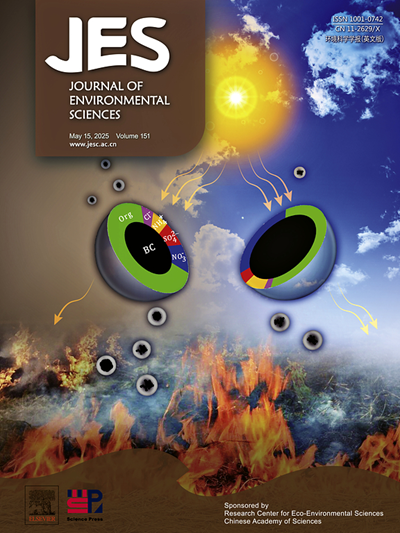上海不同天气型下的HCHO和NO2廓线特征
IF 5.9
2区 环境科学与生态学
Q1 ENVIRONMENTAL SCIENCES
引用次数: 0
摘要
大尺度天气模式对气象条件和大气污染有显著影响,但对甲醛(HCHO)和二氧化氮(NO2)垂直分布的影响研究较少。2020年6月1日至2021年12月31日,利用多轴差分光学吸收光谱(MAX-DOAS)对上海市城市、近郊和沿海农村3种典型环境NO2和HCHO垂直剖面进行观测。HCHO水平以城郊站点最高,NO2水平以城市站点最高。HCHO主要分布在海拔0 ~ 1 km之间,NO2主要集中在地面附近。HCHO与NO2的比值用于识别臭氧形成机制,臭氧敏感性随环境区域、季节和海拔而变化。利用t型方法和台风“in - fa”的主成分分析,从垂直方向分析了天气型对HCHO和NO2的影响。HCHO浓度呈低压型;均压式>;各高程层均为高压型,而NO2浓度则相反。气象因子(特别是辐射、温度、相对湿度、云量和风)、外部输送和初始排放对不同天气类型的HCHO和NO2水平的差异有贡献。“In-Fa”案例显示了这种特殊的天气模式如何通过改善气象条件、促进生物前体和改变气团方向来提高HCHO和NO2水平。本研究评估了天气模式对上海市HCHO和NO2垂直分布的影响,为了解污染原因提供了新的思路。本文章由计算机程序翻译,如有差异,请以英文原文为准。

HCHO and NO2 profile characteristics under different synoptic patterns in Shanghai, China
Large-scale synoptic patterns significantly affect meteorological conditions and air pollution, yet their impacts on the vertical distribution of formaldehyde (HCHO) and nitrogen dioxide (NO2) have been little studied. From 1 June 2020 to 31 December 2021, Multi-AXis-Differential Optical Absorption Spectroscopy (MAX-DOAS) was used to observe NO2 and HCHO vertical profiles in three typical environments of Shanghai, China, representing urban, suburban and coastal rural environments, respectively. HCHO level is the highest at suburban site, NO2 is the highest at urban site. HCHO is mainly distributed between 0 and 1 km in altitude, and NO2 is concentrated near the ground. The ratio of HCHO to NO2 is used to identify ozone formation regimes, ozone sensitivities vary with environmental area, season and altitude. The principal component analysis in the T-mode approach and typhoon “In-Fa” case is applied to analyze the effects of synoptic patterns on HCHO and NO2 vertically. HCHO concentrations show a pattern of low-pressure type > uniform-pressure type > high-pressure type at each altitude layer, while NO2 concentrations follow the opposite pattern. Meteorological factors (especially radiation, temperature, relative humidity, cloud cover and wind), external transport and initial emissions contribute to the differences in HCHO and NO2 levels across synoptic types. The “In-Fa” case shows how this special synoptic pattern elevates HCHO and NO2 levels by improving meteorological conditions, boosting biogenic precursors and shifting air mass directions. This study assesses the impacts of synoptic patterns on HCHO and NO2 vertical distribution in Shanghai, offering insights into understanding causes of pollution.
求助全文
通过发布文献求助,成功后即可免费获取论文全文。
去求助
来源期刊

Journal of Environmental Sciences-china
环境科学-环境科学
CiteScore
13.70
自引率
0.00%
发文量
6354
审稿时长
2.6 months
期刊介绍:
The Journal of Environmental Sciences is an international journal started in 1989. The journal is devoted to publish original, peer-reviewed research papers on main aspects of environmental sciences, such as environmental chemistry, environmental biology, ecology, geosciences and environmental physics. Appropriate subjects include basic and applied research on atmospheric, terrestrial and aquatic environments, pollution control and abatement technology, conservation of natural resources, environmental health and toxicology. Announcements of international environmental science meetings and other recent information are also included.
 求助内容:
求助内容: 应助结果提醒方式:
应助结果提醒方式:


